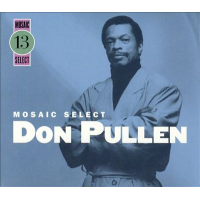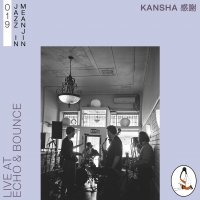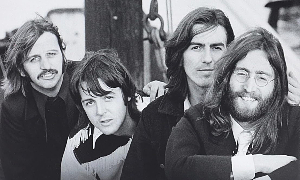Home » Jazz Articles » Book Review » Jazz in Search of Itself
Jazz in Search of Itself
Jazz in Search of Itself touches on nearly all the major issues and figures to appear in jazz over the past fifty years and then some, spotlighting a few unexpected names along the way...
 Larry Kart
Larry KartJazz in Search of Itself
Yale University Press
ISBN 0-30010-420-0
2004
"In every case," writes Larry Kart in his preface to Jazz in Search of Itself , "the pieces collected here came to be written because other people asked for them." Those mysterious "other people" include editors and higher-ups at the Chicago Tribune and Down Beat , but this shouldn't suggest that the impetus behind Kart's writing on jazz is solely one of money or obligation. The essays, interviews and reviews assembled in this book demonstrate his enduring love of the music and a fine critical ear for it.
Jazz in Search of Itself justifies its publication on the basis of the introduction alone. Here Kart describes in a nutshell the unique history of jazz and posits reasons for its personal and general appeal as well as its longevity. He is fascinated by what he calls in the two-page preface "this music's perpetual intimate narrative" in addition to its roots in self-expression, in support of which he cites Carl Dahlhaus' analysis that 'expressionist' composers - and by extension, jazz musicians - present to the public their "'intelligible I,' the analogue of the poet's 'lyric ego.'" This resolute belief in self-expression as one of the defining characteristics of jazz appears again and again in Kart's work, shaping his assessments of Sonny Rollins, Wayne Shorter, Wynton Marsalis and pianist Bill Evans. It also partly explains the existential title.
Kart's tastes are broad, ranging from the downhome exuberance of Tin Pan Alley to the abstract philosophizing of Cecil Taylor. This eclecticism extends beyond music, too, enabling him to draw apposite comparisons between jazz music and, for example, the poetry of Tennyson, William Carlos Williams, Rimbaud and Pinsky, not to mention the philosophy of Ortega y Gassett and the fiction of Jack Kerouac (who has a piece devoted entirely to his own relation to jazz). These touchstones not only put the jazz under review into some kind of context for the non-musician or the newcomer; they also remind the reader that jazz is and always has been more than just music. It is a social and artistic phenomenon too.
One characteristic piece is the short sketch of tenor saxophonist Arnett Cobb from 1980. In the course of just 400 words or so, Kart nails one of those subtle delights that appear every so often in jazz music, this particular one being a two-note " Yah -duh" that kicked off Cobb's solo on a rendition of "Just a Closer Walk with Thee." He writes: "Now I suppose you had to be there to hear what that ' Yah -duh did, but let me assure you that within its apparent simplicity there was more musical meaning than words could exhaust... And listening to it one could feel a literal loosening in the knees, an invitation to enter a realm of sensuous physicality." This is the sort of event - and a written account to match - that makes one fall in love with jazz all over again. Similar onomatopoeic renderings of Ellington's "The Sergeant Was Shy" (the "Dee-doodle- doo ... dee-doodle- doo " of the clarinets and the trumpets' " boo -bop, boo-bop-boo-bop") mix lightheartedness with a novelist's quest for descriptive accuracy.
Another noteworthy piece, written rather early in Kart's career in 1969, is the first one on Lee Konitz in the section on Tristano-ites, which despite its brevity is an especially rewarding section in Jazz in Search of Itself. "[O]ne senses that, more than any jazz musician of comparable skill, [Konitz] is often on the brink of surrendering to the impulse not to play - as though the blankness of the blank slate were so real to him that he 'writes' upon it with some reluctance." Exquisitely put. One does not even need to have heard Konitz's music to appreciate this assessment; but for those who have its precision is remarkable. The same gift for metaphor can be found in the review of Ornette Coleman and his live performance with the band Prime Time, "the music of a man who has summoned up the gods for purposes of conversation, not worship."
Of the fifty-odd biographical pieces, the opening ones on the relatively lesser-known Chicago players - tenor saxophonist Johnny Griffin, multi-instrumentalist Ira Sullivan and drummer Wilbur Campbell (the first two are pictured on the book cover) - are perhaps the most interesting. Kart has an affinity for the Chicago scene because he grew up there and experienced it firsthand; his special enthusiasm for these three musicians comes through in his writing. He's also helped by some witty quotes like the one that closes the Campbell interview: "Every drummer who's been playing can play anything he thinks of; the trouble is thinking of things to play. Lots of cats can play what they think, but they don't think it." The reason for including some of the other pieces is less clear. The exceptionally short profile/review of Oscar Peterson from 1982, for instance, is as fervid as the pianist's playing, but in the company of the rest of these pieces it seems like an unnecessary footnote.
Over several decades of writing a critic runs the risk of repeating himself. One of Kart's causes célèbres is advancing the idea that jazz is "our major native art form," a phrase that crops up in several articles and introductions. Bebop is chained to the adjective "angular." The notion that watching Philly Joe Jones perform is "like watching someone weave lace out of barbed wire" struck me as a clever turn of phrase. Unfortunately, Kart must have been equally fond of it because he used it again when describing Don Cherry in a piece dated two years later.
But these idiosyncrasies are not half as important and contentious as his generally low estimation of pianist Bill Evans. Kart recognizes the pastoral-free split in jazz, a profound ideological rift akin to that which developed between Stravinsky and Schoenberg several decades earlier in classical music, and one that could be best personified by Ornette Coleman leading the free camp and Evans (or better still, Miles Davis, the Stravinsky-type figure incorporating new methods into the traditional) leading the other. Full of praise for Coleman's flights of fancy, Kart instead zeroes in on Evans, calling him "essentially a minor artist - a charming player, at best, but one whose music was confined to a rather narrow emotional realm whose possibilities he had largely exhausted by the early 1960s." No other player, whether renowned or obscure, comes under as much fire in Jazz in Search of Itself. What Kart tries to understand and explain in this piece on Evans is how the pianist became so influential despite his "formulaic" playing and his taste for "sugary kitsch," songs such as "What Kind of Fool Am I?" and "People". When Evans took up these sentimental tunes "as though they were not sugary kitsch but songs that deserved all the tastefulness he could lavish upon them," writes Kart, "he was as close to being emotionally fraudulent as the most cynical, manipulative cocktail lounge virtuoso." And Kart must know this opinion rankles. He devotes a four-page apologia to it.
There is a Rat Pack recording on which Sammy Davis, Jr., that consummate entertainer, sings "What Kind of Fool Am I?" with a depth and feeling so genuine it hurts. Dodging good-natured chiding from Dean Martin between lines, a contrast that may even heighten the sense of authenticity, he sounds as if he's in a dark bedroom at 3am desperately trying to answer the rhetorical question of the song's title. If a jaded showbiz personality like Davis, Jr. can take up this ballad with such conviction, why should Evans be shamed for doing the same? There is, of course, no disputing the fact that in the hands of too many performers "What Kind of Fool Am I?" indeed becomes mawkish and false. But Evans, despite his arguable lack of stylistic bravado, transformed no small amount of kitsch into kunst precisely because he was in earnest when dealing with these romantic tunes. To my ear, he really was trying to find and articulate the answer to what kind of fool he was - emotional representation through technical means, the process of self-expression that Kart rates so highly elsewhere. So when Kart writes, "In jazz, it's not just the material but the artist's attitude toward it that counts," in praise of Sonny Rollins' tongue-in- cheek treatment of sentimental tunes, it could be used to support either side of the case for or against Evans. Or is the attitude only acceptable when it's wry or sarcastic?
Before Evans can be accused of such artistic crimes as emotional fraudulence and cynical manipulation - and here it should be recognized that Kart has since taken all this into account and later amends his opinion accordingly - it is necessary to consider the man himself. One major clue - the key, even - lies in a quote that Kart provides in his apologia from Evans' longtime companion Peri Cousins. The unmitigated world, she says, one that hadn't been mediated with heroin or cocaine, was "too beautiful" for hypersensitive Evans to handle. "It's almost as if he had to blur the world for himself by being strung out." And in one of the concluding interviews, two 1980s talks with Tony Bennett, the singer recalls a late-night phone call from the pianist with whom he recorded two commercially and artistically successful duo albums. "All he said was, 'Tony, just think love and beauty and forget all the rest.' ... It may sound like an impossible or unrealistic attitude to take in this world where there's so much cynicism, but there must have been a reason for him to tell me that."
All my focus on Evans could be a moot point, politely brushed aside as my lashing out like a wounded animal because I happen to identify with something on a metaphysical level in much of his playing. But Evans, even during his darker years, is rarely just rooting around the bottom of the sentimentalist's bag of tricks; he is closing and opening the lid on the guarded chamber of one's soul.
The simple fact is that the "pastoral" is still capable of communicating and moving us in ways that the fractured, nebulous and occasionally overly cerebral avant and free styles cannot. This, I think, is why Evans chose to operate in this mode, and why I would claim that he had just as many hits and misses as his more consciously progressive counterparts. The evaluation Kart finally settles on, and one with which most will agree (albeit for slightly different reasons), is that "Evans was an artist whose conflicts threatened to overwhelm his gifts, and that it was his fate to spend much of the latter part of his career making a music in which those conflicts were disguised, even denied."
It would also be hard to object to Kart's writing on the preservational museum vitrine treatment of jazz that began in the 1980s, a movement spearheaded by wunderkind and press darling Wynton Marsalis. This is a topic that jazz fans have debated until raw and bleeding, and it is covered here in the aptly titled section "The Neo-Con Game." Writing in 1969 on "Jazz in the Global Village," long before the revivalist issue had taken a definite course and shape, Kart is sympathetic to the artistic motivation but skeptical of the effect that too much reverence has on the development of European jazz. The next few essays, more or less chronological, see Kart placing himself firmly on the opposite side of Marsalis and the artistic neo-conservatives. This, yet again, is another strong section in this collection, of immense use to the jazz newcomer as well as the veteran who has already formed a firm opinion on the matter.
Jazz in Search of Itself touches on nearly all the major issues and figures to appear in jazz over the past fifty years and then some, spotlighting a few unexpected names along the way such as Frank Zappa and, as mentioned before, Jack Kerouac and Tony Bennett (on the matter of repertoire, Bennett memorably says, "I'd rather have a grocery store than a big supermarket"). As far as the towering personalities of jazz go, it is reassuring to see Kart's veneration of Stan Getz somewhat tempered later on in light of the saxophonist's infamous self-centeredness. (In a fairly recent television interview, the British pianist Stan Tracey said that Getz was the sort of man who washed his hands before he stood at the urinal, so highly did he think of that part of his anatomy.) Most importantly, however, Kart shares with other reputable critics the qualities of regular insight and contagious enthusiasm. His writing invariably sends readers to the music, whether for the first time or a repeat listen, with a better understanding and appreciation for it.
Tags
PREVIOUS / NEXT
Support All About Jazz
 All About Jazz has been a pillar of jazz since 1995, championing it as an art form and, more importantly, supporting the musicians who make it. Our enduring commitment has made "AAJ" one of the most culturally important websites of its kind, read by hundreds of thousands of fans, musicians and industry figures every month.
All About Jazz has been a pillar of jazz since 1995, championing it as an art form and, more importantly, supporting the musicians who make it. Our enduring commitment has made "AAJ" one of the most culturally important websites of its kind, read by hundreds of thousands of fans, musicians and industry figures every month.



























